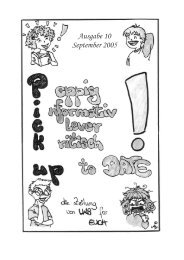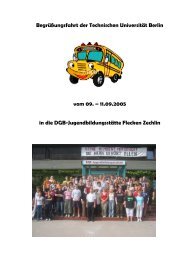Elegantes Telefax - JAV der TUB - TU Berlin
Elegantes Telefax - JAV der TUB - TU Berlin
Elegantes Telefax - JAV der TUB - TU Berlin
You also want an ePaper? Increase the reach of your titles
YUMPU automatically turns print PDFs into web optimized ePapers that Google loves.
25<br />
major problems. The internal assessments were to a large extent the results of the<br />
work of the Environment Department, created in 1987.<br />
Last, but not least, there was the criticism of individual projects in the water sector,<br />
mainly those involving larger dams, especially the report of the Morse Commission<br />
investigating at the request of the Board of Directors the compliance of the Bank with<br />
its own policies with respect to the Narmada dam in India (Morse and Berger 1992).<br />
The negative assessment of the compliance and the recommendation of the Commission<br />
to the Bank to withdraw support finally resulted in the cancellation of the<br />
World Bank funding by the Indian government. As one consequence, the Bank’s<br />
management initiated a larger internal review process at the end of 1992 to survey<br />
the compliance with resettlement policies comprehensively which was un<strong>der</strong>taken by<br />
a task force led by the environment department and included not only a review of<br />
staff reports, but consistent documentation of the resettlement portfolio and review of<br />
the numbers of displaced persons (Fox 2000; World Bank 1996a).<br />
The process to formulate a water policy took place earlier and had consi<strong>der</strong>ably<br />
lower visibility. Officially, the process was announced in early 1991, but Moore and<br />
Sklar in their account attribute the beginning of the policy formulation to a year earlier<br />
in 1990 (Moore and Sklar 2000, 354). The process was largely conceived as an internal<br />
process, led by a team from the Agriculture and Rural Development Department.<br />
The consultative process of Bank staff started with representatives from borrowing<br />
governments and the NGOs, restricted to one workshop in July 1991 (Moore<br />
and Sklar 2000). Two of the major US anti-dam NGOs organized a protest mailing<br />
which caused a new workshop in 1992 at which the NGOs demanded a policy with<br />
binding guidelines, based on a set of objectives which centered on giving priority to<br />
alternatives to large–scale projects, to the restoration of rivers and relying on public<br />
participation. After an initial search for a common ground, the process of consultation<br />
stopped, presumably due to internal differences within the Bank. The NGOs relocated<br />
their efforts to the US Congress and executive directors. After two reviews of<br />
drafts by the Board, the final draft was approved in May 1993 and released in September.<br />
The policy change in the final Policy Paper Water Resources Management is<br />
mostly conceptual, adopting the Dublin principles and linking it to the Bank’s 1992<br />
World Development Report which mainstreamed environment among the nonenvironmental<br />
economists in the Bank (Wade 1997, 712). It combines the call for a<br />
comprehensive framework, especially on a river basin level and its institutional reform<br />
with a broadening of the options in the water using sectors from the traditional<br />
supply augmentation to efficient service delivery and demand side options and includes<br />
a higher priority for environmental objectives without calling it IWRM (World





